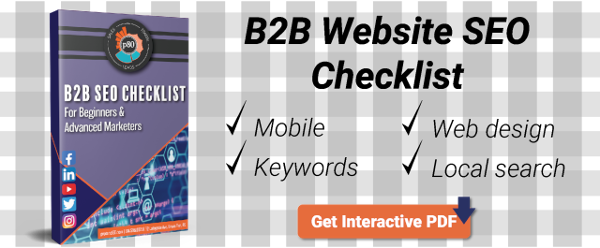Inbound Marketing Blog
for Manufacturers and Healthcare Companies
SEO & UX Checklist: Optimizing a Website for User Experience

SEO and user experience go hand-in-hand. By providing both new and recurring visitors with a seamless and pleasurable website experience, you can naturally improve your SEO, which will increase your visibility on SERPs (search engine results pages).
But how exactly does user experience affect your SEO, and what are ways you can improve it? Below we cover key SEO tasks and much more.
(Related Blog Post: B2B Website Migration Checklist)
User Experience & SEO Checklist: How Does User Experience Affect SEO?
Google, along with all other search engines (i.e. Bing, DuckDuckGo), has one primary goal: Show the most relevant and helpful results possible for the user. Not only do they determine and sort results based on relevance of the content on your page, but they also heavily factor in your website’s user experience.
There are many ways to improve your site’s user experience. Doing so will help you organically increase user traffic and average time spent on your website (a major SEO ranking factor).
Here’s a user experience and SEO checklist with five main pillars of improving your SEO and user experience:
- Mobile compatibility
- User-friendly content
- Readability
- Navigation
- Site loading speed
- Accessibility
Mobile Compatibility
In case you haven’t been paying attention for the past 10 years, the majority of people accessing the internet are using mobile devices. It goes without saying that if your site isn’t optimized for mobile compatibility, your SEO and user experience are going to suffer. (Hopefully you’ve used some sort of analytics tool to see what percentage of your site’s visitors are mobile vs. desktop users.)
Having strong mobile compatibility means you have many aspects working together to provide the best user experience possible. This includes:
- Ensuring that buttons, links, and other jump points are big enough for users on touch screens.
- Optimizing your website design so that images, links, and text aren’t jumbled together.
- Testing that your site is compatible with several different types of browsers and devices.
You can come up with other ways to improve your mobile-friendliness by simply thinking about what would reduce friction for a mobile user. This is easier to do if you have a hosting platform and content management system built with the modern buyer in mind.
User-Friendly Content
Educational content should be the focus of most webpages a user lands on. Therefore, always keep your audience in mind when creating content.
But what exactly does it mean for content to be considered user-friendly? It’s simple, really. Just think about what makes an enjoyable website experience for you.
First and foremost, the content on the page should be relevant to and educational for the topic it’s centered around. If your words fail to entertain and educate your visitors, or your title or keywords are misleading, Google will flag your site as unreliable and it’ll be difficult to gain domain authority.
Make sure you’re also using long-tail keywords to help define your audience and ensure you don’t frustrate users by bringing them somewhere irrelevant to them. This is a key indicator for search engines that your site may have relevant information for a specific query. Just don’t overdo it so you don’t get flagged for keyword stuffing.
Readability
Do you understand the importance of user-friendly content now? Good! Now it’s time to learn the importance of the readability of your content.
Readability means exactly as it sounds: It’s how easily your audience can read your content. This is determined by several factors, including:
- Font size
- Font style
- Text & background colors
- Whitespace
Another important note about the readability of your content goes beyond the actual text itself, and focuses on the way you structure it. Big blocks of paragraphs can be overwhelming to your audience, and may result in them leaving your page just as quickly as they came.
Consider breaking up your text into multiple small paragraphs to help improve readability, mixing things up occasionally with:
- Bullet or numbered lists
- Key phrases in bold
- Relevant or entertaining images
- Links to helpful first- and third-party resources
Site Navigation
Few things are more annoying in internet life than clicking on a useful-looking website, seeking out information, and getting lost or not finding it. Not only is this incredibly frustrating; it also means the lost soul likely won’t stick around for long. And if it’s the first page they’ve visited on your site, that’ll raise your bounce rate -- another SEO no-no.
Having good website navigation is about much more than having a drop-down menu. In fact, it should be near the top of any website user experience checklist. Proper website navigation makes it easier for your visitors to find the information they need and convert into a contact.
This can be achieved several ways, such as :
- Employing thorough internal linking
- Providing anchor links to easily zoom around longer pages
- Avoiding the use of image navigation.
Site Loading Speed
The best websites for user experience have blink-of-an-eye site speed. “Site speed” refers to the time it takes for a webpage to load.
Checking your site speed is one of the most effective ways to check if your site is SEO-friendly. If your site loads slowly, then both your SEO and user experience will be negatively impacted.
Ideally, your page should be loaded and fully interactive within 3 seconds. In fact, it’s been reported that sites that take even 5 seconds to load experience ...
- 35% fewer page views
- 38% fewer conversions
- A 105% higher bounce rate
… than those that load in under 5 seconds.
Accessibility
Enhancing a website's accessibility is a matter of legal compliance and ethical practice. It's also a crucial component of creating a positive user experience and boosting website searchability.
All potential clients, regardless of any disability, should be able to fully engage with your website. It makes sense -- and cents -- to be inclusive anyway, as it broadens your audience reach and increases the potential for lead generation and sales.
From a UX perspective, an accessible website provides a smoother, more intuitive process through:
- Readable fonts
- Sufficient color contrast
- Alternative text for images
- Clear navigation
These elements have something obvious in common: The make it easier for users to find the information they need.
Indirectly, making accessibility a built-in feature of your website also leads to improved SEO metrics. Many of the elements that improve accessibility, like image alt text and proper header tags, also help search engines better understand and rank your content.
Optimize for the Future
Optimizing your user experience to increase your SEO is a process that you should always stay ahead of. Google constantly updates its algorithm, and not optimizing your site regularly can cause you to suddenly fall in the rankings.
To put it in math-y terms: Any decent B2B website strategy = UX + SEO.
Once your site is optimized and gaining traffic, it’s important to make optimizations that will lead to conversions. To learn how to do this, download our free website update checklist:
(Editor's note: This blog post was originally published in June 2021 and was recently updated with new insights.)
Our Blogs, Direct to Your Inbox!
How to Audit your Online Marketing
If you are executing digital marketing, congratulations! You are most likely already one step ahead of your competition, and making strides to meaningfully connect with prospects online. But, how do you know if you’re seeing continual success year over year, and improving your metrics?
Without the tools in place to analyze and benchmark your efforts, it is impossible to scale your online marketing and ensure continuous success.




